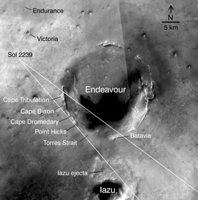
Annotated Map
Click on the image for the larger version
This map of the region around NASA's Mars Exploration Rover Opportunity shows the relative
locations of several craters and the rover in May 2010, when Opportunity took images for a
super-resolution view of the horizon to the rover's southeast (PIA13197).
The base map here is a mosaic of images from the Context Camera on NASA's Mars
Reconnaissance Orbiter. The scale bar is 5 kilometers (3.1 miles).
Opportunity explored Endurance Crater, near the upper-left corner of this map, during the first
year after the rover's January 2004 arrival on Mars for a mission originally scheduled to last
for three months. Since the summer of 2008, when Opportunity finished two years of studying
Victoria Crater, the rover's long-term destination has been the much larger Endeavour Crater.
The route chosen for the journey veers south of the shortest path between the two craters in
order to avoid hazardously large ripples of sand. By the spring of 2010, Opportunity had
covered more than a third of the charted, 19-kilometer (12-mile) route from Victoria to
Endeavour and reached an area with a gradual, southward slope offering a view of a portion of
Endeavour's elevated rim.
On this map, the southeastward lines originating from the point labeled "Sol 2239" show the
angle covered in the super-resolution view generated from a set of images that Opportunity's
panoramic camera (Pancam) took during the 2,239th Martian day, or sol, of Opportunity's
mission on Mars (May 12, 2010). The points labeled "Cape Tribulation," "Cape Byron," "Cape
Dromedary" and "Point Hicks" on this map are also visible in that Sol 2239 Pancam view, as
correlated by rover science team member Tim Parker, of NASA's Jet Propulsion Laboratory.
The science team has assigned those and other informal names for features at Endeavour
Crater using as a theme names of places visited by British Royal Navy Capt. James Cook in
his 1769-1771 Pacific voyage in command of H.M.S. Endeavour. The Pancam view also
shows some of the thick deposit of material ejected by the impact that excavated Iazu Crater,
south of Endeavour. The observed increase in brightness of Iazu's ejecta relative to
Endeavour's features is consistent with modeling by science team members Mike Wolff, of the
Space Science Institute, and Ray Arvidson,of Washington University in St. Louis, applying
optical characteristics Opportunity has measured in the Martian atmosphere.
After the rover team chose Endeavour as a long-term destination, the goal became even more
alluring when observations with the Compact Reconnaissance Imaging Spectrometer for Mars,
also on the Mars Reconnaissance Orbiter, found clay minerals exposed at Endeavour. James
Wray, of Cornell University, and co-authors reported observations of those minerals in
Geophysical Research Letters in 2009. Clay minerals, which form under wet and relatively
neutral pH conditions, have been found extensively on Mars from orbit but have not been
examined on the surface. Additional observations with that spectrometer are helping the rover
team choose which part of Endeavour's rim to visit first with Opportunity.

